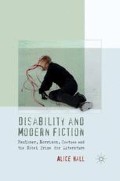Abstract
Claudia, the young female narrator of Morrison’s first novel, The Bluest Eye, is fascinated by the mysterious, seductive yet also destructive nature of beauty. As a young girl growing up in Ohio in the years following the Great Depression, she experiences a disjunction between abstract white beauty ideals and the materiality of her own female black body. Claudia asks: ‘What was the secret? What did we lack? Why was it important?’1
Access this chapter
Tax calculation will be finalised at checkout
Purchases are for personal use only
Preview
Unable to display preview. Download preview PDF.
Notes
Toni Morrison, The Bluest Eye (London: Vintage, 1999), 57.
Paul C. Taylor, ‘Malcolm’s Conk and Danto’s Colors; or, Four Logical Petitions Concerning Race, Beauty and Aesthetics’, in Beauty Matters, ed. Peg Zeglin Brand (Bloomington: Indiana University Press, 2000), 62; Katherine Stern, ‘Toni Morrison’s Beauty Formula’, in The Aesthetics of Toni Morrison: Speaking the Unspeakable, ed. Marc C. Connor (Jackson: University Press of Mississippi, 2000), 78.
W. E. B. Du Bois, ‘Criteria of Negro Art’, The Crisis 32 (1926), 293.
Eugène Delacroix, Études de Figures Volantes Nues (1836–40); Charles Le Brun, Groupes D’hommes Précipités (1672); Edgar Degas, Femme Nue, Échevelée, Penchée en Avant à Droite (1860–2).
Elaine Scarry, On Beauty and Being Just (London: Duckworth, 2000), 30.
Umberto Eco (ed.), On Beauty: A History of a Western Idea, trans. Alastair McEwen (London: Secker & Warburg, 2004), 14.
Isobel Armstrong, The Radical Aesthetic (Oxford: Blackwell, 2000), 3.
James Wood, The Broken Estate: Essays on Literature and Belief (New York: Random House, 1999), 218–19.
Toni Morrison, Sula (London: Vintage, 1998), 31.
Tobin Siebers, ‘Disability Aesthetics’, JCRT 7, 2 (2006), 65.
Wolfgang Kayser, The Grotesque in Art and Literature (New York: Columbia University Press, 1981).
Susan Willis, Specifying: Black Women Writing the American Experience (Madison: University of Wisconsin Press, 1987);Toni Morrison, ‘Rediscovering Black History’, in Toni Morrison: What Moves at the Margin, ed. Toni Morrison and Carolyn C. Denard (Jackson: University Press of Mississippi, 2008), 39–55;Davis (ed.), The Disability Studies Reader, xvi.
Naomi Wolf, The Beauty Myth (London: Anchor Books, 1992), 17.
Peg Zeglin Brand (ed.), Beauty Matters (Bloomington: Indiana University Press, 2000), 7.
Toni Morrison, Song of Solomon (London: Vintage, 1998), 149.
Toni Morrison, ‘Behind the Making of the Black Book’, Black World 23, 1 (1974), 89.
Malin LaVon Walther, ‘Out of Sight: Toni Morrison’s Revision of Beauty’, Black Literature Forum 24, 4 (1990), 777.
Bertram D. Ashe, ‘“Why Don’t He Like My Hair?” Constructing African-American Standards of Beauty in Toni Morrison’s Song of Solomon and Zora Neale Hurston’s Their Eyes Were Watching God’, African American Review 29, 4 (1995), 2.
Paula Black, The Beauty Industry: Gender, Culture, Pleasure (London: Routledge, 2004), 2–3.
Toni Morrison, Jazz (London: Vintage, 2005), 23.
Kathryn Lasky, Vision of Beauty: The Story of Sarah Breedlove Walker, illus. Nneka Bennett (New York: Walker Books, 2000).
Morrison, Tar Baby (London: Vintage, 2004), 9.
Bill Cosby, ‘Introduction’, in The Black Book, ed. Middleton A. Harris (New York: Random House, 1974), i.
Cheryl A. Wall, ‘Toni Morrison, Editor and Teacher’, in The Cambridge Companion to Toni Morrison, ed. Justine Tally (Cambridge: Cambridge University Press, 2007), 144.
Sara Blair, Harlem Crossroads: Black Writers and the Photograph in the Twentieth Century (New Haven: Princeton University Press, 2007), 259.
Cheryl A. Wall, Worrying the Line: Black Women Writers, Lineage and Literary Tradition (Chapel Hill: University of North Carolina Press, 2005), 102.
Toni Morrison, ‘Rootedness in the Ancestor’, in Black Women Writers (1950–1980): A Critical Evaluation, ed. Mari Evans (Garden City, NY: Anchor Books, 1984), 345.
bel hooks, ‘Postmodern Blackness’, Postmodern Culture 1, 1 (1990), 23.
Toni Morrison, Conversations with Toni Morrison, ed. Danille Taylor-Guthrie (Jackson: University Press of Mississippi, 1994), 247.
Barbara Johnson, The Feminist Difference: Literature, Psychoanalysis, Race and Gender (London: Harvard University Press, 1988), 86.
Toni Morrison, A Mercy (London: Chatto & Windus, 2008), 47.
Maud Ellmann, ‘The Power to Tell: Rape, Race and Afro-American Women’s Fiction’, in An Introduction to Contemporary Fiction: International Writing in English since 1970, ed. Rod Mengham (Oxford: Polity Press, 1999), 46.
Wendy Steiner, The Trouble with Beauty (London: Heinemann, 2001), xxii.
Maxine Sheets-Johnstone, The Phenomenology of Dance (London: Dance Books Ltd., 1966), 119.
D. W. Winnicott, Playing and the Reality (London: Routledge, 1971), 133–4.
Sondra Horton Fraleigh, Dance and the Lived Body: A Descriptive Aesthetics (Pittsburgh: University of Pittsburgh Press, 1987), 51.
Alice Walker, ‘Beauty: When the Other Dancer is the Self’, in In Search of Our Mother’s Gardens: Womanist Prose (London: Harcourt, 1983), 385–94.
Toni Morrison, The Dancing Mind: Speech upon Acceptance of the National Book Foundation Medal for Distinguished Contribution to American Letters (New York: Alfred A. Knopf, 1996), 16.
Ibid., 7.
Toni Morrison, ‘Home’, in The House that Race Built: Original Essays by Toni Morrison, Angela Y. Davis, Cornel West and Others on Black Americans and Politics in America Today, ed. Lubiano Waheema (New York: Pantheon Books, 1997), 5.
Copyright information
© 2012 Alice Hall
About this chapter
Cite this chapter
Hall, A. (2012). Foreign Bodies: Disability and Beauty in the Works of Toni Morrison. In: Disability and Modern Fiction. Palgrave Macmillan, London. https://doi.org/10.1057/9780230355477_3
Download citation
DOI: https://doi.org/10.1057/9780230355477_3
Publisher Name: Palgrave Macmillan, London
Print ISBN: 978-1-349-33226-7
Online ISBN: 978-0-230-35547-7
eBook Packages: Palgrave Literature CollectionLiterature, Cultural and Media Studies (R0)

